 |
Balgis Osman-Elasha discusses the many factors that make the African continent so vulnerable to environmental stress and climate change impacts. She summarizes some of the adaptation opportunities that would ensure the continent a healthy and sustainable future. |
| The author is a senior researcher at the Climate Change Unit in the Higher Council for Environment and Natural Resources in Khartoum, Sudan. | |
The increasing number of disasters since the beginning of the 21st century and their association with climate change have become a major concern for the international community, raising climate change issues to the top of the global agenda.
Africa is especially vulnerable to climatic changes and variability. This vulnerability is due to the fact that a large share of its economies depend on climate-sensitive sectors, mainly rainfed agriculture, widespread poverty, poor infrastructure, high illiteracy rates, over-exploitation of natural resources and tribal conflicts. All these factors, in addition to limited institutional and technological capabilities, have contributed to its low adaptive capacity. The continent's high physical sensitivity to climate change is expected to result in increased average temperatures and more rainfall variability, both of which are going to severely impact people's livelihoods. The knowledge and information base for decision making on expected impacts and the required adaptation measures is also low.
One of the constraints to understanding current and future climate variability is the lack of observational climate data in Africa. Significant gaps are apparent in the surface network, such as over Angola, the Congo basin, Sudan, and parts of the Sahel. This lack of data limits, for example, regional diagnostic studies, which can identify the structure of dry and wet years, their precursors and their impacts, utilizing empirical and statistical techniques and which need further support in Africa. To address this evident gap, coordinated efforts for capacity building, training, research and development should be emphasized to provide for a continent-wide monitoring network. Making reliable climate observations available would transform them into useful products for a wide spectrum of stakeholders.
This information gap is evident when observing the unsatisfactory operation of the Global Surface Network and the Global Upper Area Network in Africa. In a recent World Meteorological Organization (WMO) Annual Global Monitoring Report, it was noted that only 50 per cent of the ten upper air stations and ten per cent of the 84 surface stations are working well enough to properly provide for expected reports. It has also been reported by the WMO that about 26 per cent out of 84 of the Global Surface Networks and 20 per cent out of ten of the Global Upper Air Network stations within eastern and southern Africa are silent, and most of the remaining stations provide a less than desirable performance.
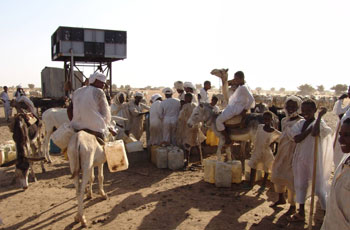 |
Water crisis in Western Sudan
© Mohamed El Gamri |
This situation creates key gaps in the understanding of and ability to predict the global climate system, resulting in the climate observing system in Africa being in a far worse state than that of any other continent. According to the WMO, this situation is deteriorating.
Requirements for increasing Africa's contribution to the global climate observing system have been identified by regional workshops and the regional action plans that followed. These requirements include:
- improving and sustaining operational observing networks, such as the Global Climate Observing System's Surface and Upper Air Networks;
- recovering historical data;
- improving national and regional coordination;
- education, training and capacity building; and,
- improved national planning and reporting.
More stations are needed - of those that are in place many are not reporting or are reporting at a sub-standard level. Africa also has a low density of WMO World Weather Watch real-time weather stations, in fact, the lowest of any region in the world.
Africa has a low level of expertise in climate science, particularly in prediction at longer time scales. Most predictions are supplied from international centres external to Africa. The continent also lags behind other regions in terms of availability of detailed scientific knowledge of its climate. Little resources are allocated to climate at national levels, since climate is seen as a lesser priority compared to other urgent needs.
Many country reports have also highlighted specific constraints and data needs to build capacity related to the vulnerability and adaptation components of National Communications. In particular, such constraints include:
- the lack of country-specific socio-economic scenarios;
- the deficiencies in data collection, quality control, archiving, retrieval, preparation and analysis of data; and,
- the lack of comprehensive studies on possible adaptation measures and cost-benefit analysis of adaptation options.
At the institutional level, many countries have stressed the critical role that local government agencies play in the development and implementation of policies and measures to address climate change.
Actions required to address these gaps include training programmes for local government officials, dedicated research activities and post-graduate courses and the initiation of specific institutional frameworks for climate change. Some parties have established training programmes for local government officials. For example, Ghana assisted its district and metropolitan assemblies to draw up local environmental action plans that contain climate change programmes and projects.
Vulnerability assessment
Africa is, it is clear, already under pressure from climate stresses and this increases the continent's vulnerability to further climate change and reduces its adaptive capacity. Floods and droughts can occur in the same area within months of each other. Droughts in Africa often lead to famine and widespread disruption of socio-economic well-being.
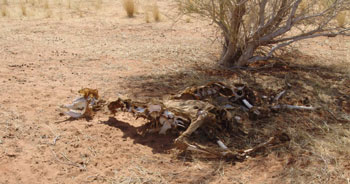 |
Loss of livestock during drought
© Mohamed El Gamri |
Atmospheric dust in the form of dust and sand storms is a major element of the Saharan and Sahelian environments. The Sahara is the world's largest source of airborne mineral dust, and according to some estimates, up to one billion tonnes of dust is exported from the Sahel-Sahara region annually, although this does vary year to year. The frequency in occurrence of dust storms has, however, increased in some parts of the Sahel, from the wet 1950s/1960s to the dry periods of the 1970s and 1980s. Human impacts such as overgrazing, deforestation and resulting desertification are contributing factors to the increase in dust storms through the creation of new sources of dust. Dust storms have negative impacts on agriculture, infrastructure and health in the dry Saharan environment. The storms can be transported over large distances, traversing northern Africa and adjacent regions, eventually depositing dust in Europe, Western Asia and the Americas.
With further climate change, climate in Africa is predicted to become more variable and extreme weather events more frequent and severe. There are likely to be large regional differences in changes in rainfall, for example, an increase in the western part of the continent and a decrease for the northern part. Some studies, however, have indicated that these general trends may include hidden variations within the regions and countries. For example, southern Africa may be drier in general terms, but some countries of the region may become wetter than the average.
General circulation models are the most common tools used for climate prediction in Africa, although they show uncertainty regarding both the magnitude and direction of changes in precipitation. The inter-annual, inter-decadal and multi-decadal variations in Africa's climate make future changes hard to understand and predict. Other climate factors important to Africa such as land-cover change, the interaction of Saharan dust and the El Niño Southern Oscillation are not represented well in these models. Better regional climate models are required, although some, such as the Hadley Centre's PRECIS model, have already been applied in some areas.
Top-down climate model scenario-based assessment is a common approach for the assessment of impacts, vulnerability and adaptation to climatic changes in Africa. Recently, though, the bottom-up approach, which places the sensitivity and vulnerability of natural and human systems to the fore, has been employed, particularly through the National Adaptation Programmes of Action process.
Key sectors and areas are likely to be seriously impacted for Africa as climate change develops.
Millions of people in Africa have no access to potable water. Water scarcity is expected to increase due to greater water demand. Population increases in drought-prone areas could, for example, coincide with future decreases in precipitation. At present, water availability is decreasing in Africa with disparities between the location of water and the need for water resources. For example, one third of the people in Africa live in drought-prone areas mainly in the Sahel, the Horn of Africa and Southern Africa. Reduction in water quantity will lead to a reduction in water quality and the associated impacts on sectors such as health and biodiversity. By 2025, it is projected that around 480 million of people in Africa will face either water scarcity or accompanying stress with a subsequent potential increase of water conflicts - almost all of the fifty river basins in Africa are transboundary.
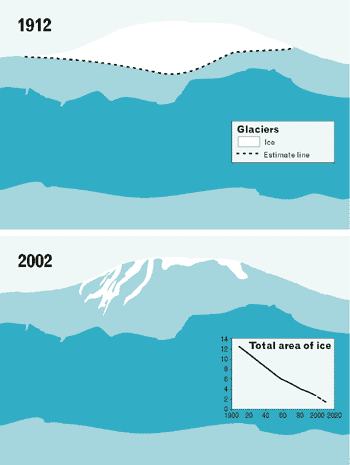 |
Figure 1: Trend in the Mount Kilimanjaro ice-cap |
The ice-cap on Mount Kilimanjaro has been disappearing due to climate change with serious implications for the rivers that depend on ice melt for their flow. Figure 1 indicates a reduction in the ice-cap of around 82 per cent since it was first surveyed in 1912. Several rivers are already drying out in the summer due to a depletion in melt water. Recent projections suggest that if the reduction continues at its present rate the ice-cap may disappear completely within fifteen years. Other glacial water reservoirs such as Ruwenzori in Uganda and Mount Kenya are facing similar threats.
Agriculture is the most important economic sector in most African countries. It represents approximately 30 per cent of Africa's GDP and contributes about 50 per cent of total export value. Figure 2 shows the food production index in Africa compared to the world's for the period 1961-2001.
Agriculture is mostly subsistence in nature with a high dependence on rainfall (over 95 per cent) for irrigation. As a result, agriculture in Africa is highly vulnerable to changes in climate variability, seasonal shifts and precipitation patterns. The food security threat posed by climate change is great, particularly where agricultural yields and per capita food production have been steadily declining and where population growth will increase the demand for food, water and forage. According to a 1996 Food and Agriculture Organization study, Africa's food supply would need to quadruple by 2050 to meet people's basic caloric needs, even under the lowest and most optimistic population projections.
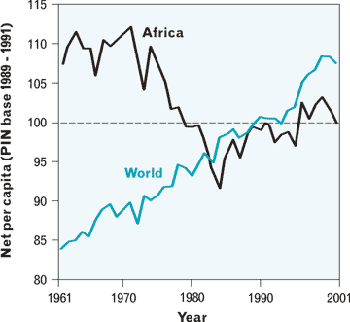 |
Figure 2: Food production index for Africa |
In general terms, the impacts of climate change on agriculture may include:
- a reduction in soil fertility;
- decreased livestock productivity directly (through higher temperatures) and indirectly (through changes in the availability of feed and fodder);
- an increased incidence of pest attacks resulting from an increase in temperature; and,
- the manifestation of vector and vector-borne diseases resulting in negative impacts on human health, which, in turn, affects the availability of manpower.
The health effects of a rapidly changing climate are likely to be overwhelmingly negative. It has been noted that the vulnerability of Africa to health impacts is a function of climatic as well many other non-climatic factors. These factors include poverty, conflicts and population displacement, and access, availability and management of health services. In addition, there are other factors such as those related to drug sensitivity of the pathogens and the general awareness and attitude towards preventive measures. Africa is already vulnerable to several climate sensitive diseases such as Rift Valley fever, cholera, malaria and heat stress. It is expected that the range, timing and severity of outbreaks of these diseases will change with a changing climate.
Africa is home to five internationally recognized areas of particularly high species richness and endemism known as 'biological hot spots'. The continent has a large and diverse heritage of flora and fauna. It contains about a fifth of all known species of plants, mammals and birds, and a sixth of amphibians and reptiles. Savannahs, which are the richest grasslands in the world, are the most extensive ecosystem in Africa.
Africa's biodiversity is currently under threat from natural and human pressures. Climate change will be an additional stressor and may lead to changes in habitats causing species migration or extinction for both flora and fauna. Sea-level rise will threaten coastal areas which are already vulnerable because of over-exploitation of coastal resources, over-population and pollution.
An increasing frequency of droughts and floods associated with climate variability and change could have a negative impact on the ecosystems of some areas in Africa. For example, lakes and reservoirs in the African Sahel could lose part of their storage capacity or completely dry up. Changing rainfall patterns could lead to soil erosion, the siltation of rivers and the deterioration of watersheds. Wetlands, of international importance, and wildlife are also under threat from drought in Southern Africa. An increase in temperature could impact the montane biodiversity of east Africa, specifically those species with a limited ability to move up in elevations.
The detrimental effect that climate change is expected to have on natural resources will lead to increased competition for those resources still available. Conflict is a possible outcome.
More than 25 per cent of Africa's population lives within 100km of the coast, and projections suggest that the number of people at risk from coastal flooding will increase from the one million in 1990 to 70 million in 2080. Sea levels around Africa are projected to rise by 15-95cm by the year 2100. Sea-level rise threatens coastal and marine ecosystems such as lagoons and mangrove forests of both eastern and western Africa. It will also impact urban centres and ports, such as Cape Town, Maputo and Dar es Salaam. An estimated 30 per cent of Africa's coastal infrastructure could be at risk including coastal settlements in the Gulf of Guinea, Senegal, the Gambia and Egypt.
Impacts of sea-level rise could include:
- reduced productivity of coastal fisheries;
- coral bleaching;
- mass migration of populations from the coast and associated health issues;
- salt water intrusion;
- loss of recreational beach facilities; and,
- a loss of coastal infrastructure such as ports and subsequent negative impacts on the tourism sector.
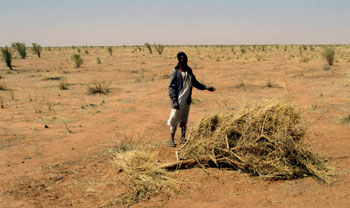 |
Deforestation in arid areas
© Mohamed El Gamri |
Africa's desertification is strongly linked to poverty, since poor people have little choice but to over-exploit the land. Extensive agriculture in the drylands of Africa and the heavy dependence of rural people on natural resources for subsistence has largely contributed to land degradation and desertification. This situation could be further aggravated by the impacts of expected climatic changes (a decrease in precipitation and an increase in temperatures). Projected climate change by the year 2025, associated with a rise in mean temperature, will exacerbate the losses already experienced due to drought. The link between desertification and climate change is an important issue that needs to be better explored.
Climate change has the potential to undermine economic development, increasing poverty and delaying or preventing the realization of the Millennium Development Goals. In particular, the lack of effective adaptation to the adverse effects of climate change can jeopardize the achievement of Millennium Development Goal 1, which is the eradication of extreme poverty and hunger, Goal 6, which is the combating of HIV/AIDS, malaria and other diseases, and Goal 7, which is to ensure environmental sustainability.
A direct link is obvious between climate change and development. The impacts of climate change could greatly impede development efforts in key sectors. Development strategies and plans could have an impact on the capacity to cope with climate change.
In consideration of the fact that the adverse effects of climate change pose an additional burden in meeting development goals, the mainstreaming of adaptation into sustainable development planning and the accommodation of additional climate change risks are issues that are under consideration for support through additional funding. For example, the Organization for Economic Cooperation and Development member countries declared in the Declaration on Integrating Climate Change Adaptation into Development Cooperation that they will work to better integrate climate change adaptation in development planning and assistance, both within their own governments and in activities undertaken with partner countries.
In 2003, the European Commission produced a communication entitled Climate Change in the Context of Development Cooperation, in which it proposed a European Union action plan aimed at integrating climate change concerns into their development cooperation activities. Similarly, the World Bank's progress report on its investment framework for clean energy and development asserts that, "it is essential that the Bank Group, along with other International Financial Institutions, play a leading role in ensuring that maximum impact is obtained from these [climate treaty] funds by mainstreaming appropriate investment and appropriate risk in the global development portfolio."
Competition for scarce resources, such as freshwater, land or fish resources, brought about by changes in climate can lead to conflict which will impact on the successful achievement of the Millennium Development Goals. The 2001 IPCC Third Assessment Report highlights conflicts over water resources, especially in international shared basins, as an important aspect of Africa's vulnerability to climate change. One such an example is that increased pressure on resources deepened tensions between nomads and agriculturalists in Niger during the 2005 crisis. It has also been argued that increased competition over land was one of the triggers of the conflict in Darfur in Western Sudan.
Adaptation strategies
In spite of the low adaptive capacity of Africa, there are some African communities that have developed traditional adaptation strategies to cope with climate variability and extreme events.
Rural farmers have been practicing coping strategies and other tactics, especially in places where droughts recur, and have developed their own ways of assessing the prospects for favourable household or village seasonal food production. For example, in Senegal and Burkina Faso, locals have improved their adaptive capacity by using traditional pruning and fertilizing techniques to double tree densities in semi-arid areas. These help hold soils together, thus reversing desertification. Similar community-initiated projects in Madagascar and Zimbabwe have also been viewed as successes. Othe examples are given in the Box that follows.
| Examples of coping strategies in African countries |
|---|
|
Experience with these strategies needs to be shared among communities, although some of these techniques may need to be adjusted to deal with additional climate risks associated with climate change.
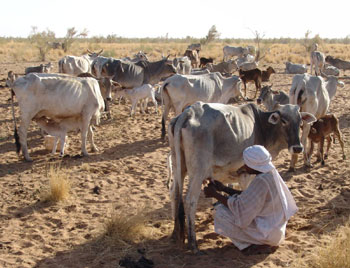 |
Nomads in the Sudan
© Mohamed El Gamri |
Opportunities for Africa
In spite of the gloomy picture that climate change is drawing for the future of Africa, the continent possesses some unique characteristics which could provide good opportunities for it to emerge stronger and more capable of reducing future climate change impacts.
The following points illustrate positive characteristics that would enable Africa to better withstand climate change impacts.
- Africa is still not heavily polluted and is not considered to be a major source of greenhouse gas emissions. Compared to the industrialized countries of Europe and North America, Africa's contribution to global climate change is not significant. Fossil fuel carbon dioxide emissions are low in both absolute and per capita terms. Its emissions represent only 3.5 per cent of the world's total carbon dioxide emissions and these are expected to increase to only 3.8 per cent by the year 2010. This means that the continent has a good chance to follow a sustainable development path.
- Africa is home to some of the greatest wilderness areas in the world, as well as some of the greatest biodiversity hotspots. The GLOBIO analysis shows that the great deserts and the Central African rainforests have huge remaining tracts that show low human impact and development.
- Africa has a population density of 249 people per 1,000 hectares, which is low compared to the world average of 442. Population projections show a decline in fertility from 6.1 children per woman in 1995 to 2.9 by 2025. This will be accompanied by a slow and uneven decline in mortality. A positive aspect is that life expectancy is expected to increase from the 50.1 years it was between 1995 and 2000 to 62.1 by 2025.
- Africa has good potential for exploiting its agricultural and range lands in a more productive way through agricultural transformation processes and sustainable use of its rich natural resource base.
- Africa participated fully in the United Nations Conference on Environment and Development in Rio de Janeiro, Brazil, in 1992 and had great expectations from the vision of global cooperation for sustainable development. This promised positive advancement if the African countries would join hands in the implementation of Agenda 21. It is still hoped that the envisioned harmony between economic development and the environment will manifest itself in Africa achieving sustainable development at national and regional levels.
- Africa is pursuing accelerated socio-economic development strategies to eradicate poverty and protect and promote human health. This is being achieved through commitments to two main initiatives that have been designed to propel Africa towards achievement of a sustainable development path in the 21st century. The two initiatives are the Poverty Reduction Strategies, which are spearheaded by the World Bank, and the International Monetary Fund and the Partnership for African Development. Further support to strengthen these initiatives is needed through re-thinking and full commitment to development by governments.
- Excellent opportunities exist for Africa to make use of available multilateral funding. For example, there is the Strategic Priority on Adaptation which is part of the Global Environment Facility Trust Fund. There is also both the Special Climate Change Fund and the Least Developed Countries Fund, which are in addition to the Adaptation Fund under the Kyoto Protocol.
- Africa possesses a wealth of social networks that have enabled people to survive throughout an environment of harsh climatic conditions. These networks represent safety nets for many of the people through compensation for their low financial incomes and helping many maintain their livelihoods. These networks should be built upon and further strengthened.
Approaches that address multiple environmental stresses and factors hold the greatest promise for Africa, particularly given the limitations in capacity, in terms of both human capacity and financial resources. Efforts to design implementation strategies that address land degradation (which leads to desertification), loss of biological diversity and ecosystem services, as well as adaptation to climate change, such as through enhancing adaptive capacity, will be more likely to succeed than uncoordinated efforts.
Many African countries have ratified the international conventions on biodiversity, climate change and desertification. Support is still needed, though, from their development partners to ensure effective implementation of their emerging strategies and plans, as well as to fully exploit the opportunities that could be achieved.
There is also a need for employing an integrated and synergetic approach among national level development partners for addressing sustainable development. Currently, various national institutions have enacted environmental action plans to address environmental degradation. Several strategies and plans have been formulated in a number of countries including national environmental action plans, forestry management plans, biodiversity plans, coastal management plans and wetland conservation strategies.
In conclusion, it is clear that although Africa is highly vulnerable to changing climate conditions and to environmental stress, with a full commitment to cooperation and utilization of the many mechanisms that are available, the continent can take positive advantage of adaptation opportunities to ensure a sustainable future.
Acknowledgements
This article is based on a background paper on impacts, vulnerability and adaptation to climate change in Africa prepared for the African Workshop on Adaptation (Accra, Ghana, September 2006) by Balgis Osman-Elasha (Team Leader), Mahmoud Medany, Isabelle Niang-Diop, Tony Nyong, Ramadjita Tabo and Coleen Vogel. The paper was commissioned by the Climate Change Secretariat.
Further information
Balgis Osman-Elasha, Climate Change Unit, Higher Council for Environment and Natural Resources, PO Box 10488, Khartoum, Sudan. Fax: +249-183-787617. Email: balgis@yahoo.com.
On the Web
The Tiempo Climate Cyberlibrary maintains a listing of key websites covering climate change and Africa.